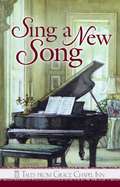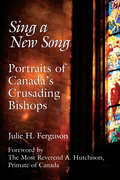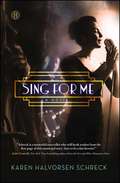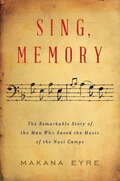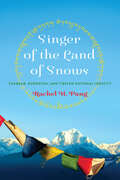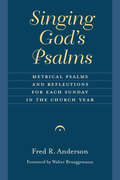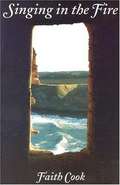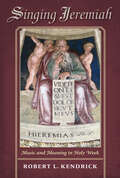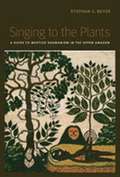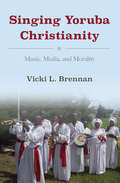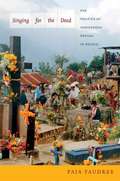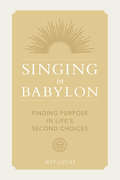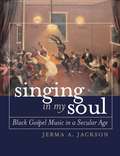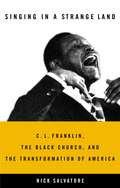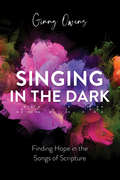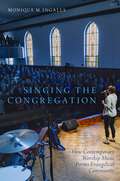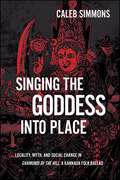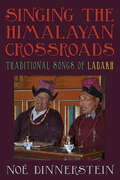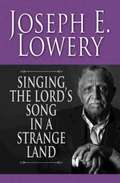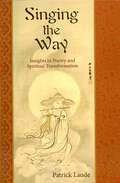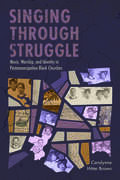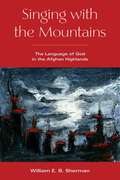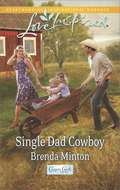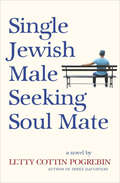- Table View
- List View
Sing a New Song (Tales from Grace Chapel Inn #36)
by Sunni JeffersAs the long days of autumn linger, the Howard sisters are ready to try new things. Louise heads out west to a music camp, and though she is skeptical, she ends up learning a new style of piano playing. Jane decides to try cooking for a whole new audience kids- and Alice finds some old photo albums and embarks on a project that will shed new light on their family history. In the meantime, a scrapbooking retreat at the inn gathers friends from near and far. As the women create beautiful books to display their most treasured keepsakes, they create new memories that none of them will ever forget. The event is a great success, providing an opportunity for connections to be made and hearts to be healed.
Sing a New Song: Portraits of Canada's Crusading Bishops
by Julie H. FergusonFor the first time, Sing a New Song tells the stories of four Canadian bishops who pushed the envelope and changed the world. All have faced severe opposition; one was involved in the only Anglican schism in Canadian history; two jeopardized their careers; and one was voted the sixth most important person of the twentieth century whose world view has transformed the wider society. Over the last 150 years, George Hills, David Somerville, Douglas Hambidge, and Michael Ingham adopted unpopular causes with their eyes wide open. They were the men who fought for and won rights for aboriginals, women, and gays and lesbians. In finely drawn and thoroughly researched biographies, Julie H. Ferguson weaves the bishops’ impact on society into Canada’s history while delivering compelling insights into their personal and spiritual lives. Meet this quartet of sharply contrasting and fearless bishops in Sing a New Song.
Sing for Me: A Novel
by Karen Halvorsen SchreckWhen a good church girl starts singing in a jazz club and falls for the music--as well as a handsome African American man--she struggles to reconcile her childhood faith with her newfound passions. Raised in the Danish Baptist Church, Rose Sorensen knows it's wrong to sing worldly songs. But Rose still yearns for those she hears on the radio--"Cheek to Cheek," "Smoke Gets in Your Eyes"--and sings them when no one is around. One day, Rose's cousin takes her to Calliope's, a jazz club, where she discovers an exciting world she never knew existed. Here, blacks and whites mingle, brought together by their shared love of music. And though Rose worries it's wrong--her parents already have a stable husband in mind for her--she can't stop thinking about the African American pianist of the Chess Men, Theo Chastain. When Rose returns to the jazz club, she is offered the role of singer for the Chess Men. The job would provide money to care for her sister, Sophy, who has cerebral palsy--but at what cost? As Rose gets to know Theo, their fledgling relationship faces prejudices she never imagined. And as she struggles to balance the dream world of Calliope's with her cold, hard reality, she also wrestles with God's call for her life. Can she be a jazz singer? Or will her faith suffer because of her worldly ways? Set in Depression-era Chicago and rich in historical detail, Sing for Me is a beautiful, evocative story about finding real, unflinching love and embracing--at all costs--your calling.
Sing to Me of Dreams
by Kathryn Lynn DavisIn the grand tradition of The Far Pavilions, The Thorn Birds, and Kathryn Lynn Davis's own magnificent New York Times bestseller, Too Deep for Tears, Sing to Me of Dreams is a rich, sensuous, deeply imagined novel filled with the intimate yearnings and passions of a turbulent family, their lovers and friends, and the extraordinary woman who entered their lives. There is a future I do not seek, but which will come to be, just the same....With these words echoing in her heart, Saylah, born of a white father and Indian mother, set off on a journey that would take her through all the mysteries of the human heart. As a child, she came to know the bounty of the earth and sea, the clear streams, and she guarded the secret wisdom of her close-knit Indian people. But when tragedy devastated her loved ones, Saylah was forced to leave her home and enter the world of the Ivys, an English-born family whose European traditions were as strange to her as her spirit world was to them. The Ivys had come to the lush, fertile Pacific Northwest in pursuit of a dream -- to build a paradise of prosperity and freedom. Until Saylah came to them, their dream had been denied. Julian Ivy had a dream of his own. An impatient young man in whom refinement and rage were intertwined, he was drawn to Saylah's healing power and disturbing beauty. Through heartbreak and joy, Julian and Saylah would discover the richness of love...but no one could resolve for her the conflicts of her heritage. Heeding the call of her destiny, she would finally make the most wrenching choice of all....
Sing, Memory: The Remarkable Story of the Man Who Saved the Music of the Nazi Camps
by Makana EyreA Polish musician, a Jewish conductor, a secret choir, and the rescue of a trove of music from the Sachsenhausen concentration camp. On a cold October night in 1942, SS guards at the Sachsenhausen concentration camp violently disbanded a rehearsal of a secret Jewish choir led by conductor Rosebery d’Arguto. Many in the group did not live to see morning, and those who survived the guards’ reprisal were deported to Auschwitz-Birkenau just a few weeks later. Only one of its members survived the Holocaust. Yet their story survives, thanks to Aleksander Kulisiewicz. An amateur musician, he was not Jewish, but struck up an unlikely friendship with d’Arguto in Sachsenhausen. D’Arguto tasked him with a mission: to save the musical heritage of the victims of the Nazi camps. In Sing, Memory, Makana Eyre recounts Kulisiewicz’s extraordinary transformation from a Polish nationalist into a guardian of music and culture from the Nazi camps. Aided by an eidetic memory, Kulisiewicz was able to preserve for posterity not only his own songs about life at the camp, but the music and poetry of prisoners from a range of national and cultural backgrounds. They composed symphonies, organized clandestine choirs, arranged great pieces of music by illustrious composers, and gathered regularly over the course of the war to perform for one another. For many, music enabled them to resist, bear witness, and maintain their humanity in some of the most brutal conditions imaginable. After the war, Kulisiewicz returned to Poland and assembled an archive of camp music, which he went on to perform in more than a dozen countries. He dedicated the remainder of his life to the memory of the Nazi camps. Drawing on oral history and testimony, as well as extensive archival research, Eyre tells this rich and affecting human story of musical resistance to the Nazi regime in full for the first time.
Singer of the Land of Snows: Shabkar, Buddhism, and Tibetan National Identity (Traditions and Transformations in Tibetan Buddhism)
by Rachel H. PangThe singular role of Shabkar in the development of the idea of Tibet Shabkar (1781–1851), the &“Singer of the Land of Snows,&” was a renowned yogi and poet who, through his autobiography and songs, developed a vision of Tibet as a Buddhist &“imagined community.&” By incorporating vernacular literature, providing a narrative mapping of the Tibetan plateau, reviving and adapting the legend of Tibetans as Avalokiteśvara&’s chosen people, and promoting shared Buddhist values and practices, Shabkar&’s concept of Tibet opened up the discursive space for the articulation of modern forms of Tibetan nationalism. Employing analytical lenses of cultural nationalism and literary studies, Rachel Pang explores the indigenous epistemologies of identity, community, and territory that predate contemporary state-centric definitions of nation and nationalism in Tibet and provides the definitive treatment of this foundational figure.
Singing God's Psalms: Metrical Psalms and Reflections for Each Sunday in the Church Year (Calvin Institute of Christian Worship Liturgical Studies)
by Fred R. AndersonDrawing on his decades of experience as a pastor, hymn writer, and hymnal consultant, Fred Anderson here offers pastors and worship leaders a rich treasury of singable psalms — one for each psalm text or canticle appointed in the three-year Revised Common Lectionary. Anderson renders each psalm into metered text, using contemporary, biblical, inclusive language, and suggests appropriate pairings with familiar hymn tunes. Short pastoral reflections on each psalm text provide background on what is being sung — and are also useful for sermon preparation and personal meditation.
Singing Jeremiah: Music And Meaning In Holy Week (Music And The Early Modern Imagination Ser.)
by Robert L. KendrickA defining moment in Catholic life in early modern Europe, Holy Week brought together the faithful to commemorate the passion, crucifixion, and resurrection of Jesus Christ. In this study of ritual and music, Robert L. Kendrick investigates the impact of the music used during the Paschal Triduum on European cultures during the mid-16th century, when devotional trends surrounding liturgical music were established; through the 17th century, which saw the diffusion of the repertory at the height of the Catholic Reformation; and finally into the early 18th century, when a change in aesthetics led to an eventual decline of its importance. By considering such issues as stylistic traditions, trends in scriptural exegesis, performance space, and customs of meditation and expression, Kendrick enables us to imagine the music in the places where it was performed.
Singing To The Plants: A Guide To Mestizo Shamanism In The Upper Amazon
by Stephan V. BeyerIn the Upper Amazon, mestizos are the Spanish-speaking descendants of Hispanic colonizers and the indigenous peoples of the jungle. Some mestizos have migrated to Amazon towns and cities, such as Iquitos and Pucallpa; most remain in small villages. They have retained features of a folk Catholicism and traditional Hispanic medicine, and have incorporated much of the religious tradition of the Amazon, especially its healing, sorcery, shamanism, and the use of potent plant hallucinogens, including ayahuasca. The result is a uniquely eclectic shamanist culture that continues to fascinate outsiders with its brilliant visionary art. Ayahuasca shamanism is now part of global culture. Once the terrain of anthropologists, it is now the subject of novels and spiritual memoirs, while ayahuasca shamans perform their healing rituals in Ontario and Wisconsin. Singing to the Plants sets forth just what this shamanism is about--what happens at an ayahuasca healing ceremony, how the apprentice shaman forms a spiritual relationship with the healing plant spirits, how sorcerers inflict the harm that the shaman heals, and the ways that plants are used in healing, love magic, and sorcery.
Singing Yoruba Christianity: Music, Media, and Morality
by Vicki L. BrennanSinging the same song is a central part of the worship practice for members of the Cherubim and Seraphim Christian Church in Lagos, Nigeria. Vicki L. Brennan reveals that by singing together, church members create one spiritual mind and become unified around a shared set of values. She follows parishioners as they attend choir rehearsals, use musical media—hymn books and cassette tapes—and perform the music and rituals that connect them through religious experience. Brennan asserts that church members believe that singing together makes them part of a larger imagined social collective, one that allows them to achieve health, joy, happiness, wealth, and success in an ethical way. Brennan discovers how this particular Yoruba church articulates and embodies the moral attitudes necessary to be a good Christian in Nigeria today.
Singing for the Dead: The Politics of Indigenous Revival in Mexico
by Paja FaudreeSinging for the Dead chronicles ethnic revival in Oaxaca, Mexico, where new forms of singing and writing in the local Mazatec indigenous language are producing powerful, transformative political effects. Paja Faudree argues for the inclusion of singing as a necessary component in the polarized debates about indigenous orality and literacy, and she considers how the coupling of literacy and song has allowed people from the region to create texts of enduring social resonance. She examines how local young people are learning to read and write in Mazatec as a result of the region's new Day of the Dead song contest. Faudree also studies how tourist interest in local psychedelic mushrooms has led to their commodification, producing both opportunities and challenges for songwriters and others who represent Mazatec culture. She situates these revival movements within the contexts of Mexico and Latin America, as well as the broad, hemisphere-wide movement to create indigenous literatures. Singing for the Dead provides a new way to think about the politics of ethnicity, the success of social movements, and the limits of national belonging.
Singing in Babylon: Finding Purpose in Life's Second Choices
by Jeff LucasEveryone has to live with second choices—events and circumstances that they would not choose, some trivial, some tragic. Daniel was a man whose life was filled with second choices, but he did more than just survive; he stayed faithful to God and thrived. So what is there to learn from his story in Scripture? Pastor and author Jeff Lucas challenges readers to ask, &“How can we, like Daniel, be faithful in the &‘Babylon&’ of second choices?&” Down-to-earth but inspirational, Singing in Babylon explores how the reader, like Daniel, can find purpose and meaning in life&’s second choices.
Singing in My Soul
by Jerma A. JacksonBlack gospel music grew from obscure nineteenth-century beginnings to become the leading style of sacred music in black American communities after World War II. Jerma A. Jackson traces the music's unique history, profiling the careers of several singers--particularly Sister Rosetta Tharpe--and demonstrating the important role women played in popularizing gospel.Female gospel singers initially developed their musical abilities in churches where gospel prevailed as a mode of worship. Few, however, stayed exclusively in the religious realm. As recordings and sheet music pushed gospel into the commercial arena, gospel began to develop a life beyond the church, spreading first among a broad spectrum of African Americans and then to white middle-class audiences. Retail outlets, recording companies, and booking agencies turned gospel into big business, and local church singers emerged as national and international celebrities. Amid these changes, the music acquired increasing significance as a source of black identity.These successes, however, generated fierce controversy. As gospel gained public visibility and broad commercial appeal, debates broke out over the meaning of the music and its message, raising questions about the virtues of commercialism and material values, the contours of racial identity, and the nature of the sacred. Jackson engages these debates to explore how race, faith, and identity became central questions in twentieth-century African American life.
Singing in a Strange Land: C. L. Franklin, the Black Church, and the Transformation of America
by Nick SalvatoreNick Salvatore's Singing in a Strange Land tells the story of C. L. Franklin (1915-1984), one of the greatest black preachers in American history. The father of Aretha Franklin, C. L. was a spellbinding preacher who channeled his charisma into his gospel music and compelling sermons which spoke through faith to the personal and social problems rural African Americans encountered in their migration north. Stressing unity between the sacred and the profane allowed him to embrace all aspects of African American culture, and jazz, blues, and gospel performers mingled in his Detroit home. Franklin also embraced the night life that surrounded his musician friends, even as he served on the Executive Board of the Southern Christian Leadership Council and organized the 1963 "Walk Toward Freedom" march with his close friend, Martin Luther King, Jr. In June of 1979, Franklin was shot during a robbery of his home, and died five years later. Over 10,000 people attended his funeral at the Detroit church he made famous, the New Bethel Baptist Church. Nick Salvatore spent over eight years doing research and conducting interviews to present Franklin's biography in amazing detail. Singing in a Strange Land tells the story of black migration and activism, alongside the rise of gospel, blues, and soul music, with a cast of characters including Martin Luther King, Jr., B. B. King, Art Tatum, Coleman Young, Jesse Jackson, Clara Ward, Mahalia Jackson, and many others.
Singing in the Dark: Finding Hope in the Songs of Scripture
by Ginny OwensFar too often, life&’s challenges and questions cause people to fight feelings of doubt and despair, as they search endlessly for hope. In Singing in the Dark, Ginny Owens introduces the reader to powerful ways of drawing closer to God and how the elements of music, prayer, and lament offer rich, vibrant, and joyful communion with Him, especially on the darkest days. Ginny has gained a unique life perspective, as she has lived without sight since age three. She brings rich, biblical teaching that will encourage readers and compel them to dig deep into the beautiful songs, prayers, and poetry of Scripture—the same words through which the people of the Bible flourished in impossible circumstances. Singing in the Dark includes reflection and journaling prompts at the end of each chapter.
Singing the Congregation: How Contemporary Worship Music Forms Evangelical Community
by Monique M. IngallsContemporary worship music shapes the way evangelical Christians understand worship itself. Author Monique M. Ingalls argues that participatory worship music performances have brought into being new religious social constellations, or "modes of congregating". Through exploration of five of these modes--concert, conference, church, public, and networked congregations--Singing the Congregation reinvigorates the analytic categories of "congregation" and "congregational music." Drawing from theoretical models in ethnomusicology and congregational studies, Singing the Congregation reconceives the congregation as a fluid, contingent social constellation that is actively performed into being through communal practice--in this case, the musically-structured participatory activity known as "worship." "Congregational music-making" is thereby recast as a practice capable of weaving together a religious community both inside and outside local institutional churches. Congregational music-making is not only a means of expressing local concerns and constituting the local religious community; it is also a powerful way to identify with far-flung individuals, institutions, and networks that comprise this global religious community. The interactions among the congregations reveal widespread conflicts over religious authority, carrying far-ranging implications for how evangelicals position themselves relative to other groups in North America and beyond.
Singing the Goddess into Place: Locality, Myth, and Social Change in Chamundi of the Hill, a Kannada Folk Ballad (SUNY series in Hindu Studies)
by Caleb SimmonsSinging the Goddess into Place examines Chamundi of the Hill, a collection of songs that tells the stories of the gods and goddesses of the region around the city of Mysore in southern Karnataka. The ballad actively transforms the region into a land where gods and goddesses live, embedding these deities within the social worlds of their devotees and remapping southern Karnataka into sacred geography connected through networks of devotion and pilgrimage. In this in-depth study of the songs and their context, Caleb Simmons not only provides the first English-language translation of these songs but brings to light the unstudied folk perspectives on the foundational myth of Mysore and its urban history. Singing the Goddess into Place demonstrates how folk narratives reflect local context while also actively working to upend social inequities based on caste and ritual/devotional practices. By delving into this world, the book helps us understand how a landscape is transformed through people's relationship with it and how this relationship helps build meaning for the communities that call it home.
Singing the Himalayan Crossroads: Traditional Songs of Ladakh
by Noé DinnersteinIntroduces the traditional songs of Himalayan Ladakh through their history, ethnology, poetry, and Tibetan Buddhism beliefs.Singing the Himalayan Crossroads places the traditional song repertoires of the former Himalayan kingdom of Ladakh in both their historical and modern contexts. Although scholarly, it is aimed at a broad general audience, including people interested in ethnomusicology, Tibet, Buddhism, the Silk Road, or the music and cultures of Central and South Asia.While many songs contain texts that evoke Buddhist meditative visualization practices, at the same time, Muslims, both Sunni and Shia, were prominent in Silk Road caravans that enriched the Buddhist aristocracy. Songs from these Muslim traders often mention important religious sites in Kashmir while having nostalgia for the sights of the Ladakhi capital, Leh. Interweaving these themes, author Noé Dinnerstein mixes a relaxed, conversational narrative with the music and poetry of the songs to evoke the crossroads of High Asia.A separate anthology of recordings is available online.
Singing the Lord's Song in a Strange Land 35011
by Joseph E. LoweryFrom the earliest meetings of the Civil Rights Movement to offering the benediction for the first African American President of the United States, Rev. Dr. Joseph Lowery has been an eyewitness to some of the most significant events in our history. But, more important, he has been a voice that speaks truth to power--inspiring change that moves us forward.In Singing the Lord's Song in a Strange Land, you will find Dr. Lowery's most enduring speeches and messages from the past fifty years including Coretta Scott King's funeral and the benediction given at President Obama's inauguration. This book, however, is not simply a collection of words. It is the heart of a movement and a call to a new generation to carry the mantle--for all people.
Singing the Way: Insights into Poetry & Spiritual Transformation
by Patrick LaudeSinging the Way explores the relationship between poetry and true contemplation. Author Patrick Laude seeks first to disperse romantic notions of how the poetic process works, but goes on to suggest that it is inherently more profound than modern practitioners imagine. Laude tells us that in itself true poetry is "transformative" since it brings the soul and all its faculties under the catalytic &“spell&” of the sacred through the mediation of rhythm and the &“lure&” of imaginal and verbal beauty. Singing the Way illustrates its points through examples drawn from five rich spiritual and poetic traditions (viz. Hinduism, Sufism, China, Japan, and the European Neo-Platonic and Romantic current).
Singing through Struggle: Music, Worship, and Identity in Postemancipation Black Churches
by Carolynne Hitter BrownSinging through Struggle: Music, Worship, and Identity in Postemancipation Black Churches offers an innovative look at the vital role music and worship played in nurturing Black citizenship and identity during the Reconstruction era. In such border cities as Baltimore, Washington, DC, and Philadelphia, the church was where newly emancipated migrants and members of the free Black community merged identities, priorities, and experiences through a process of cultural negotiation. Music, as a sign of Black achievement and as a genuine expression of identity, produced both bastions and battlegrounds in the fight for democracy.The music of Black churchgoers, singing together in sanctuaries as well as in homes, schools, and outdoors, expressed resistance to uplift ideologies within and to white supremacy without. Even while using hymns and music of the European sacred tradition, members infused the songs they chose with new meanings relevant to their evolving concerns and situations. Drawing on fresh archival sources, Singing through Struggle sheds light on the unexplored gap in the study of African American religious music between slavery and the Great Migration, demonstrating the continuous stream of Black creativity and dignity that existed in religious music making between gospel music and the spirituals. This close-up investigation of three Black congregations draws out previously forgotten stories of men and women who understood church music as key to shaping a collective purpose and civic identity. Their stories demonstrate how faith, music, and ritual gave the Black community means for exploring a deeply complex and ever-changing reality.
Singing with the Mountains: The Language of God in the Afghan Highlands
by William ShermanWinner, Carolina's Outstanding Contribution to Middle East and Islamic Studies Book AwardAn illuminating story of a Sufi community that sought the revelation of GodIn the Afghan highlands of the sixteenth century, the messianic community known as the Roshaniyya not only desired to find God’s word and to abide by it but also attempted to practice God’s word and to develop techniques of language intended to render their own tongues as the organs of continuous revelation. As their critics would contend, however, the Roshaniyya attempted to make language do something that language should not do—infuse the semiotic with the divine. Their story thus ends in a tower of skulls, the proliferation of heresiographies that detailed the sins of the Roshaniyya, and new formations of “Afghan” identity.In Singing with the Mountains, William E. B. Sherman finds something extraordinary about the Roshaniyya, not least because the first known literary use of vernacular Pashto occurs in an eclectic, Roshani imitation of the Qur’an. The story of the Roshaniyya exemplifies a religious culture of linguistic experimentation. In the example of the Roshaniyya, we discover a set of questions and anxieties about the capacities of language that pervaded Sufi orders, imperial courts, groups of wandering ascetics, and scholastic networks throughout Central and South Asia.In telling this tale, Sherman asks the following questions: How can we make language shimmer with divine truth? How can letters grant sovereign power and form new “ethnic” identities and ways of belonging? How can rhyme bend our conceptions of time so that the prophetic past comes to inhabit the now of our collective moment? By analyzing the ways in which the Roshaniyya answered these types of questions—and the ways in which their answers were eventually rejected as heresies—this book offers new insight into the imaginations of religious actors in the late medieval and early modern Persianate worlds.
Single Dad Cowboy (Cooper Creek)
by Brenda MintonWhen a young woman returns to Oklahoma, she leaves her difficult past behind—and discovers a forever family—in this Western romance series finale.Harmony Cross returns to Dawson, Oklahoma determined to start over—and hoping to keep a low profile. She needs time and space, not complications. Especially not in the form of the charming Dylan Cooper. But the handsome cowboy is not the man Harmony remembers. These days, Dylan is a single dad with two sweet and vulnerable children to raise. Harmony never thought she’d see the day—not only is Dylan more kindhearted than she ever imagined, but she’s falling for the last man she ever thought she’d love. Perhaps this particular complication is exactly what she’s been searching for . . .
Single Jewish Male Seeking Soul Mate: A Novel
by Letty Cottin PogrebinThis novel &“unflinchingly confronts the issue of Jewish continuity in a diverse and changing America&” (Anne Roiphe, author and journalist). Feminist icon Letty Cottin Pogrebin&’s second novel is the story of Zach Levy, the left-leaning son of Holocaust survivors who promises his mother on her deathbed that he will marry within the tribe and raise Jewish children. When he falls for Cleo Scott, an African American activist grappling with her own inherited trauma, he must reconcile his old vow to the family he loves with the present reality of the woman who may be his soul mate. A New York love story complicated by the legacies and modern tensions of Jewish American and African American history, Single Jewish Male Seeking Soul Mate explores what happens when the heart runs counter to politics, history, and the compelling weight of tradition. &“A beautifully written and heartwarming masterpiece.&” —Menachem Z. Rosensaft, founding chair of the International Network of Children of Jewish Holocaust Survivors &“Cleareyed, courageous.&” —Kirkus Reviews
